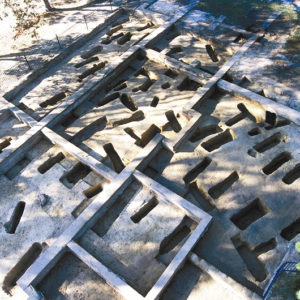Finding the scattered remains of the 14-year-old English girl we now call “Jane” did not seem unusual at first when they appeared in the L-shaped cellar last summer. There are hundreds of burials scattered across the James Fort area, and different eras of construction have disturbed many of those burials.
In the 20 years of the Jamestown Rediscovery Project, archaeologists have fully excavated 90 burials of European men, women and children. These individuals include some of the original gentlemen, laborers, at least one Indian war casualty, and a captain found just outside the fort walls.
The archaeologists have also mapped hundreds of unmarked graves to complete the picture of life and death at Jamestown.
Burials tell more of the story of the settlement than just written accounts and artifacts can tell, according to Dr. William M. Kelso, head of archaeological research at Historic Jamestowne.
“Literally coming face-to-face with the remains of the real people of early Jamestown brings home, in a very personal way, the full story of the settlement effort,” Kelso said.
The study of more than 70 individuals in an unmarked burial ground on the western end of the island provided information on a cross-section of the population that suffered the hardships of early Jamestown. The burials were beneath the foundations of the 1660s Statehouse on the western end of the island (where the Voorhees Archaearium building stands today).
Over 18 months, the Jamestown Rediscovery team excavated 63 graves and recovered the skeletal remains of 72 individuals. Some of the burials were shallow and haphazard. Some shafts held multiple burials: 10 graves held two burials each, and one shaft had three burials in it. These graves may date to the “starving time” winter of 1609-10—the same time when Jane died.
Some of the people in this burial ground were interred wearing their clothing, which was unusual for the time because clothing was in extremely short supply and considered part of a person’s estate. Perhaps the burial of a person who died from an infectious disease would be done hastily, in a way that minimized contact with the victim’s skin.
Analysis of these graves gives more insight into the harsh Jamestown experience. While the age of death ranged from infancy to the late 40s, almost half the population died in their twenties: men 21 to 25, women 26 to 30. Fourteen percent of them died before age two. Most were adult males, but the sample also includes adolescents, young adults, and middle-aged adults. There is some evidence for childhood malnutrition and disease and strenuous physical activity among the adults.
And sometimes the bones of one individual are the dramatic story. The discovery of Jane provides the first forensic evidence of survival cannibalism in Colonial America.
During the 2012 field season, Kelso and the Jamestown Rediscovery archaeological team excavated a cellar room found within the 1607 James Fort site. The space was used as a kitchen/bakery with two masonry ovens. When abandoned, the cellar was filled in with 1609-1610 “starving time” refuse. Lying among butchered animal bones and other artifacts discarded by the colonists during the “starving time” winter of 1609-1610, archaeologists found the partial skull and leg bone of the 17th-century English girl.
Kelso said the team has occasionally found other human bones and teeth that show no signs of processing for survival cannibalism, likely separated from original unmarked burials by early earth moving activities by the colonists. In 20 years of digging, the Jamestown Rediscovery team has found four damaged skulls not in graves. Two exhibited signs of trauma but not survival cannibalism. (One had a surgical trephination done to relieve cranial pressure in response to a skull fracture and then underwent an autopsy. Marks on the other skull show that the individual sustained a mortal blow to the head.)
But Kelso recognized Jane’s remains could be different. They were found in soil used by the settlers to fill in the abandoned cellar—soil that also contained butchered horses and dogs that were eaten during the desperate winter of 1609-1610. All of this refuse was first accumulated in a common trash pit and then ultimately redeposited when Governor De La Warr and his men arrived and proceeded to “cleanse” the town.
Study of the cellar bones by the Smithsonian Institution determined that soft tissue had been cut from the bones, evidence of cannibalism. This confirmed several documentary accounts of survival cannibalism during the depths of the “starving time” winter. This discovery brings Jane back to remind us of how close Jamestown came to failing before it endured as the first permanent English colony in North America.
related images
- Human Skull Found in an Early James Fort Well
- Indications of a Trephination Attempt
- Excavated burials at the Statehouse site








